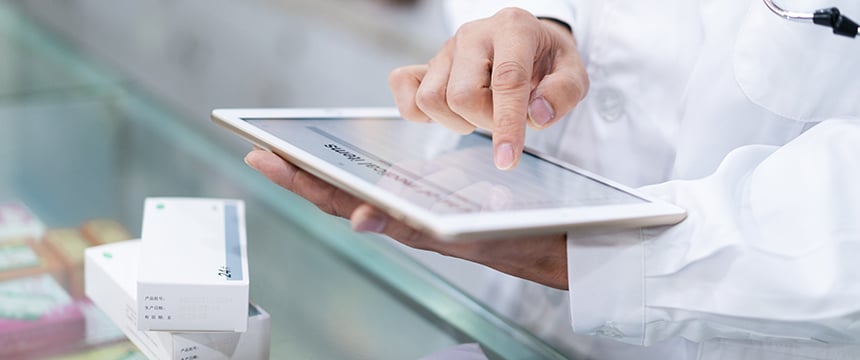
On November 16, 2021, the Drug Enforcement Agency (DEA) issued an advance notice of proposed rulemaking, exploring whether or not to create new federal regulations governing the practice of telepharmacy. These regulations would govern the receipt of prescriptions and dispensing of controlled substances by pharmacists practicing across multiple states. The DEA hopes such regulations will impose uniformity and standardization to a healthcare industry that increasingly draws on technology and multistate geographic footprints to reduce costs, increase patient access, and drive convenient delivery of medications to consumers. The DEA’s notice provides the industry with an opportunity to provide insight and feedback that may help shape the new regulations.
What is Telepharmacy?
The term telepharmacy is not defined under Federal law, but typically involves a remote pharmacist delivering pharmacist care via telecommunication technologies to a patient located at a dispensing site. Such pharmacist care may include, but is not limited to: the dispensing and distribution of prescription drugs, drug use review, patient counseling services, and drug therapy monitoring. Depending on the relevant state authority and regulations, telepharmacies may fill paper prescriptions or electronic prescriptions.
The practice of telepharmacy varies from state to state, but current models generally fall within one of two categories:
- Brick and mortar remote sites are traditional, storefront businesses, physically staffed by non-pharmacist employees, e.g., pharmacy technicians, who are remotely supervised by a pharmacist located in a separate ‘‘parent’’ or ‘‘hub’’ pharmacy, via continuous and real-time computer, video, and audio links (i.e., telecommunication connection). Depending on the state, a pharmacy technician may assist the remote pharmacist by receiving and inputting prescriptions into the pharmacy’s information management system and preparing prescriptions for dispensing.
- Self-service, automated machines are kiosks (think vending machine but for prescription drugs) which contain pharmacy prescription medication/inventory, labeling equipment, and the telecommunication technology that connects the patient-user to the remote pharmacist via real-time video and audio links. Such automated machines may accept prescriptions or refill orders, store prepackaged or repackaged medications, label and dispense patient-specific prescriptions, and ultimately dispense the prescription to the patient-user.
What Does This Mean for Online or Mail Order Pharmacies?
Perhaps not much. The practice of telepharmacy differs from online pharmacies or mail order pharmacies, which often contract with telemedicine companies to serve as a fulfillment option for patients. Online pharmacies are regulated at the federal level under the Ryan Haight Online Pharmacy Consumer Protection Act of 2008, which requires these pharmacies register with the DEA. But most online pharmacies are exempt from this registration if they dispense only electronically-prescribed controlled substances. Indeed, there are no online pharmacies registered with the DEA. Many states have also implemented laws and regulations governing telepharmacy practices, but variations and inconsistencies among these laws create hurdles for telepharmacy businesses that seek to operate across state lines.
Despite the specter of increased regulation and its potential to stifle innovation, the DEA has asked stakeholders to share ideas, recommendations, and insight on current pharmacy practices, which will be used to help shape future regulations. The notice sets forth 39 specific questions the DEA would like to hear comments on, such as the adequacy of remote pharmacist supervision, common ownership of hub pharmacies and remote kiosks, security standards, drug diversion and pedigree, accessibility and safety requirements, and the manner in which the telepharmacist verifies prescriptions filled remotely. Read the complete list of 39 questions here.
How to Submit Comments to the DEA
Pharmacies, technology companies, and virtual care entrepreneurs interested in telepharmacy should consider providing comments. DEA is soliciting comments until 11:59 p.m. on January 18, 2022. Anyone may submit comments – anonymously or otherwise – via electronic submission at this link. When commenting, refer to file code RIN 1117–AB74/Docket No. DEA–759 in your submission. Alternatively, commenters may submit comments by mail to:
- Drug Enforcement Administration, Attn: DEA Federal Register Representative/DPW, 8701 Morrissette Drive, Springfield, VA 22152–2639.
Telepharmacy can offer a meaningful shift in the scope and processes of pharmacy practice. The regulators often are slow to adopt different and often more efficient ways to deliver telehealth care services. The prescribing and dispensing of controlled substances is a particularly sensitive area given the abuse of opioids and other controlled substances. The DEA notice indicates that there is a recognition and opportunity to help shape this change in telepharmacy. Now is the time to make your voice heard.
Want to Learn More?
- EDGE Policy Conference | American Telemedicine Association
- 50 State Map of MAC Laws – Can PBMs No Longer Rely on ERISA Preemption to Avoid Certain State Laws?
- HHS Expands and Clarifies Scope of Immunity under the PREP Act
For more information on telemedicine, telehealth, virtual care, remote patient monitoring, digital health, and other health innovations, including the team, publications, and representative experience, visit Foley’s Telemedicine & Digital Health Industry Team.


